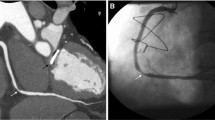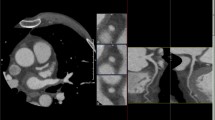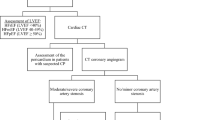Abstract
Purpose of Review
Cardiac computed tomography (CT) is becoming a more widely applied tool in the diagnosis and management of a variety of cardiovascular conditions, including heart failure. The aim of this narrative review is to examine the role of cardiac CT in patients with heart failure.
Recent Findings
Coronary computed tomographic angiography has robust diagnostic accuracy for ruling out coronary artery disease. These data are reflected in updated guidelines from major cardiology organizations. New roles for cardiac CT in myocardial imaging, perfusion scanning, and periprocedural planning, execution, and monitoring are being implemented.
Summary
Cardiac CT is useful in ruling out coronary artery disease its diagnostic accuracy, accessibility, and safety. It is also intricately linked to invasive cardiac procedures that patients with heart failure routinely undergo.





Similar content being viewed by others
References
Papers of particular interest, published recently, have been highlighted as: • Of importance
Virani SS, Alonso A, Benjamin EJ, et al. Heart Disease and Stroke Statistics—2020 Update: A Report From the American Heart Association. Circulation. 2020;141.https://doi.org/10.1161/CIR.0000000000000757.
Cook C, Cole G, Asaria P, et al. The annual global economic burden of heart failure. Int J Cardiol. 2014;171:368–76. https://doi.org/10.1016/j.ijcard.2013.12.028.
Shemesh J, Tenenbaum A, Fisman EZ, et al. Coronary calcium as a reliable tool for differentiating ischemic from nonischemic cardiomyopathy. Am J Cardiol. 1996;77:191–4. https://doi.org/10.1016/S0002-9149(96)90596-2.
Budoff MJ, Shavelle DM, Lamont DH, et al. Usefulness of electron beam computed tomography scanning for distinguishing ischemic from nonischemic cardiomyopathy. J Am Coll Cardiol. 1998;32:1173–8. https://doi.org/10.1016/S0735-1097(98)00387-8.
Peng AW, Mirbolouk M, Orimoloye OA, et al. Long-Term All-Cause and Cause-Specific Mortality in Asymptomatic Patients With CAC ≥1,000: Results From the CAC Consortium. JACC Cardiovasc Imaging. 2020;13:83–93. https://doi.org/10.1016/j.jcmg.2019.02.005.
Eberhard M, Hinzpeter R, Schönenberger ALN, et al. Incremental Prognostic Value of Coronary Artery Calcium Score for Predicting All-Cause Mortality after Transcatheter Aortic Valve Replacement. Radiology. 2021;301:105–12. https://doi.org/10.1148/radiol.2021204623.
Budoff MJ, Jacob B, Rasouli ML, et al. Comparison of Electron Beam Computed Tomography and Technetium Stress Testing in Differentiating Cause of Dilated Versus Ischemic Cardiomyopathy. J Comput Assist Tomogr. 2005;29:699–703. https://doi.org/10.1097/01.rct.0000175503.87578.0d.
Le T, Ko JY, Tina Kim H, et al. Comparison of echocardiography and electron beam tomography in differentiating the etiology of heart failure. Clin Cardiol. 2000;23:417–20. https://doi.org/10.1002/clc.4960230608.
Patel AA, Fine J, Naghavi M, Budoff MJ. Radiation exposure and coronary artery calcium scans in the society for heart attack prevention and eradication cohort. Int J Cardiovasc Imaging. 2019;35:179–83. https://doi.org/10.1007/s10554-018-1431-0.
Fihn SD, Gardin JM, Abrams J, et al. 2012 ACCF/AHA/ACP/AATS/PCNA/SCAI/STS Guideline for the Diagnosis and Management of Patients With Stable Ischemic Heart Disease. Circulation. 2012;126:e354–471. https://doi.org/10.1161/CIR.0b013e318277d6a0.
Stolzmann P, Goetti R, Baumueller S, et al. Prospective and retrospective ECG-gating for CT coronary angiography perform similarly accurate at low heart rates. Eur J Radiol. 2011;7.
Pontone G. Diagnostic Accuracy of Coronary Computed Tomography Angiography. 2009;54:10.
Maruyama T, Takada M, Hasuike T, et al. Radiation Dose Reduction and Coronary Assessability of Prospective Electrocardiogram-Gated Computed Tomography Coronary Angiography. J Am Coll Cardiol. 2008;52:1450–5. https://doi.org/10.1016/j.jacc.2008.07.048.
Sun M, Lu B, Wu R, et al. Diagnostic accuracy of dual-source CT coronary angiography with prospective ECG-triggering on different heart rate patients. Eur Radiol. 2011;21:1635–42. https://doi.org/10.1007/s00330-011-2107-5.
Cornily J-C, Gilard M, Gal GL, et al. Accuracy of 16-detector Multislice Spiral Computed Tomography in the initial evaluation of dilated cardiomyopathy. Eur J Radiol. 2007;61:84–90. https://doi.org/10.1016/j.ejrad.2006.08.010.
Andreini D, Pontone G, Pepi M, et al. Diagnostic Accuracy of Multidetector Computed Tomography Coronary Angiography in Patients With Dilated Cardiomyopathy. J Am Coll Cardiol. 2007;49:2044–50. https://doi.org/10.1016/j.jacc.2007.01.086.
Andreini D, Pontone G, Bartorelli AL, et al. Sixty-Four–Slice Multidetector Computed Tomography: An Accurate Imaging Modality for the Evaluation of Coronary Arteries in Dilated Cardiomyopathy of Unknown Etiology. Circ Cardiovasc Imaging. 2009;2:199–205. https://doi.org/10.1161/CIRCIMAGING.108.822809.
Ghostine S, Caussin C, Habis M, et al. Non-invasive diagnosis of ischaemic heart failure using 64-slice computed tomography. Eur Heart J. 2008;29:2133–40. https://doi.org/10.1093/eurheartj/ehn072.
Le Polain de Waroux J-B, Pouleur A-C, Goffinet C, et al. Combined coronary and late-enhanced multidetector-computed tomography for delineation of the etiology of left ventricular dysfunction: comparison with coronary angiography and contrast-enhanced cardiac magnetic resonance imaging. Eur Heart J. 2008;29:2544–51. https://doi.org/10.1093/eurheartj/ehn381.
Boulmier D, Audinet C, Heautot J-F, et al. Clinical contributions of 64-slice computed tomography in the evaluation of cardiomyopathy of unknown origin. Arch Cardiovasc Dis. 2009;102:685–96. https://doi.org/10.1016/j.acvd.2009.06.004.
Lee D, Li D, Jug B, et al. Diagnostic accuracy of 64 slice multidetector coronary computed tomographic angiography in left ventricular systolic dysfunction. IJC Heart Vasc. 2015. https://doi.org/10.1016/j.ijcha.2015.04.007
Srichai MB. Dual source computed tomography coronary angiography in new onset cardiomyopathy. World J Radiol. 2012;4:258. https://doi.org/10.4329/wjr.v4.i6.258.
Oncel D, Oncel G, Tastan A. Effectiveness of Dual-Source CT Coronary Angiography for the Evaluation of Coronary Artery Disease in Patients with Atrial Fibrillation: Initial Experience1. Radiology. 2007. https://doi.org/10.1148/radiol.2453070094.
Rist C, Johnson TR, Müller-Starck J, et al. Noninvasive Coronary Angiography Using Dual-Source Computed Tomography in Patients With Atrial Fibrillation. Invest Radiol. 2009;44:159–67. https://doi.org/10.1097/RLI.0b013e3181948b05.
Marwan M, Pflederer T, Schepis T, et al. Accuracy of dual-source computed tomography to identify significant coronary artery disease in patients with atrial fibrillation: comparison with coronary angiography. Eur Heart J. 2010;31:2230–7. https://doi.org/10.1093/eurheartj/ehq223.
Zhang J-J, Liu T, Feng Y, et al. Diagnostic Value of 64-Slice Dual-Source CT Coronary Angiography in Patients with Atrial Fibrillation: Comparison with Invasive Coronary Angiography. Korean J Radiol. 2011;8.
Abdelkarim MJ, Ahmadi N, Gopal A, et al. Noninvasive quantitative evaluation of coronary artery stent patency using 64-row multidetector computed tomography. J Cardiovasc Comput Tomogr. 2010;4:29–37. https://doi.org/10.1016/j.jcct.2009.10.014.
Jug B, Papazian J, Gupta M, et al. Diagnostic performance of computed tomographic coronary angiography in patients with end-stage renal disease. Coron Artery Dis. 2013;24:135–41. https://doi.org/10.1097/MCA.0b013e32835be39a.
Menke J, Unterberg-Buchwald C, Staab W, et al. Head-to-head comparison of prospectively triggered vs retrospectively gated coronary computed tomography angiography: Meta-analysis of diagnostic accuracy, image quality, and radiation dose. Am Heart J. 2013;165:154-163.e3. https://doi.org/10.1016/j.ahj.2012.10.026.
Gulati M, Levy PD, Mukherjee D, et al. 2021 AHA/ACC/ASE/CHEST/SAEM/SCCT/SCMR Guideline for the Evaluation and Diagnosis of Chest Pain: Executive Summary: A Report of the American College of Cardiology/American Heart Association Joint Committee on Clinical Practice Guidelines. Circulation. 2021:CIR0000000000001030. https://doi.org/10.1161/CIR.0000000000001030.
• McDonagh TA, Metra M, Adamo M, et al. 2021 ESC Guidelines for the diagnosis and treatment of acute and chronic heart failure. Eur Heart J. 2021;42:3599–726. https://doi.org/10.1093/eurheartj/ehab368. 2021 AHA guidelines on chest pain give a class 1A recommendation to both coronary CTA in intermediate-risk patients with acute chest pain and no known CAD, after a negative or inconclusive evaluation for acute coronary syndrome. This is a large shift from the prior 2012 class IIb recommendation, which represents the influx of new data surrounding coronary CTA in the last 10 years.
• Narula J, Chandrashekhar Y, Ahmadi A, et al. SCCT 2021 Expert Consensus Document on Coronary Computed Tomographic Angiography: A Report of the Society of Cardiovascular Computed Tomography. J Cardiovasc Comput Tomogr. 2021;15:192–217. https://doi.org/10.1016/j.jcct.2020.11.001. 2021 ESC guidelines on heart failure call coronary CTA a “key element” in the workup of patients with heart failure of unknown etiology. This strong, affirmative language from a respected multi-national organization legitimizes the utility of coronary CTA in this patient population.
Hamirani YS, Isma’eel H, Larijani V, et al. The Diagnostic Accuracy of 64-Detector Cardiac Computed Tomography Compared With Stress Nuclear Imaging in Patients Undergoing Invasive Cardiac Catheterization. J Comput Assist Tomogr. 2010;34:645–51. https://doi.org/10.1097/RCT.0b013e3181e3d0b1.
Budoff MJ, Rasouli ML, Shavelle DM, et al. Cardiac CT Angiography (CTA) and Nuclear Myocardial Perfusion Imaging (MPI)—A Comparison in Detecting Significant Coronary Artery Disease. Acad Radiol. 2007;14:252–7. https://doi.org/10.1016/j.acra.2006.11.006.
Budoff MJ, Li D, Kazerooni EA, et al. Diagnostic Accuracy of Noninvasive 64-row Computed Tomographic Coronary Angiography (CCTA) Compared with Myocardial Perfusion Imaging (MPI). Acad Radiol. 2017;24:22–9. https://doi.org/10.1016/j.acra.2016.09.008.
Danad I, Raijmakers PG, Driessen RS, et al. Comparison of Coronary CT Angiography, SPECT, PET, and Hybrid Imaging for Diagnosis of Ischemic Heart Disease Determined by Fractional Flow Reserve. JAMA Cardiol. 2017;2:1100. https://doi.org/10.1001/jamacardio.2017.2471.
Ohta Y, Kitao S, Yunaga H, et al. Myocardial Delayed Enhancement CT for the Evaluation of Heart Failure: Comparison to MRI. Radiology. 2018;288:682–91. https://doi.org/10.1148/radiol.2018172523.
Scully PR, Bastarrika G, Moon JC, Treibel TA. Myocardial Extracellular Volume Quantification by Cardiovascular Magnetic Resonance and Computed Tomography. Curr Cardiol Rep. 2018;20:15. https://doi.org/10.1007/s11886-018-0961-3.
Bandula S, White SK, Flett AS, et al. Measurement of Myocardial Extracellular Volume Fraction by Using Equilibrium Contrast-enhanced CT: Validation against Histologic Findings. Radiology. 2013;269:396–403. https://doi.org/10.1148/radiol.13130130.
Chang S, Han K, Youn J-C, et al. Utility of Dual-Energy CT-based Monochromatic Imaging in the Assessment of Myocardial Delayed Enhancement in Patients with Cardiomyopathy. Radiology. 2018;287:442–51. https://doi.org/10.1148/radiol.2017162945.
Wichmann JL, Bauer RW, Doss M, et al. Diagnostic accuracy of late iodine-enhancement dual-energy computed tomography for the detection of chronic myocardial infarction compared with late gadolinium-enhancement 3-T magnetic resonance imaging. Invest Radiol. 2013;48:851–6. https://doi.org/10.1097/RLI.0b013e31829d91a8.
Zhao L, Ma X, Delano MC, et al. Assessment of myocardial fibrosis and coronary arteries in hypertrophic cardiomyopathy using combined arterial and delayed enhanced CT: comparison with MR and coronary angiography. Eur Radiol. 2013;23:1034–43. https://doi.org/10.1007/s00330-012-2674-0.
Aikawa T, Oyama-Manabe N, Naya M, et al. Delayed contrast-enhanced computed tomography in patients with known or suspected cardiac sarcoidosis: A feasibility study. Eur Radiol. 2017;27:4054–63. https://doi.org/10.1007/s00330-017-4824-x.
Deux J-F, Mihalache C-I, Legou F, et al. Noninvasive detection of cardiac amyloidosis using delayed enhanced MDCT: a pilot study. Eur Radiol. 2015;25:2291–7. https://doi.org/10.1007/s00330-015-3642-2.
Bing R, Cavalcante JL, Everett RJ, et al. Imaging and Impact of Myocardial Fibrosis in Aortic Stenosis. JACC Cardiovasc Imaging. 2019;12:283–96. https://doi.org/10.1016/j.jcmg.2018.11.026.
Kittleson MM, Maurer MS, Ambardekar AV, et al. Cardiac Amyloidosis: Evolving Diagnosis and Management: A Scientific Statement From the American Heart Association. Circulation. 2020;142:e7–22. https://doi.org/10.1161/CIR.0000000000000792.
Garcia-Pavia P, Rapezzi C, Adler Y, et al. Diagnosis and treatment of cardiac amyloidosis: a position statement of the ESC Working Group on Myocardial and Pericardial Diseases. Eur Heart J. 2021;42:1554–68. https://doi.org/10.1093/eurheartj/ehab072.
Mandoli GE, D’Ascenzi F, Vinco G, et al. Novel Approaches in Cardiac Imaging for Non-invasive Assessment of Left Heart Myocardial Fibrosis. Front Cardiovasc Med. 2021;8:614235. https://doi.org/10.3389/fcvm.2021.614235.
Liguori C, Farina D, Vaccher F, et al. Myocarditis: imaging up to date. Radiol Med (Torino). 2020;125:1124–34. https://doi.org/10.1007/s11547-020-01279-8.
Attili AK, Schuster A, Nagel E, et al. Quantification in cardiac MRI: advances in image acquisition and processing. Int J Cardiovasc Imaging. 2010;26 Suppl 1:27–40. https://doi.org/10.1007/s10554-009-9571-x.
Li Y, Yu M, Dai X, et al. Detection of Hemodynamically Significant Coronary Stenosis: CT Myocardial Perfusion versus Machine Learning CT Fractional Flow Reserve. Radiology. 2019;293:305–14. https://doi.org/10.1148/radiol.2019190098.
Takx Richard AP, Blomberg BA, El AH, et al. Diagnostic Accuracy of Stress Myocardial Perfusion Imaging Compared to Invasive Coronary Angiography With Fractional Flow Reserve Meta-Analysis. Circ Cardiovasc Imaging. 2015;8:e002666. https://doi.org/10.1161/CIRCIMAGING.114.002666.
Natarajan N, Patel P, Bartel T, et al. Peri-procedural imaging for transcatheter mitral valve replacement. Cardiovasc Diagn Ther. 2016;6:144–59. https://doi.org/10.21037/cdt.2016.02.04.
• Prosper A, Shinbane J, Maliglig A, et al. Left Atrial Appendage Mechanical Exclusion: Procedural Planning Using Cardiovascular Computed Tomographic Angiography. J Thorac Imaging. 2020;35:W107–18. https://doi.org/10.1097/RTI.0000000000000504. SCCT consensus document on the TAVR solidifies the role of coronary CTA in TAVR programs.
Van de Veire NR, Marsan NA, Schuijf JD, et al. Noninvasive Imaging of Cardiac Venous Anatomy With 64-Slice Multi-Slice Computed Tomography and Noninvasive Assessment of Left Ventricular Dyssynchrony by 3-Dimensional Tissue Synchronization Imaging in Patients With Heart Failure Scheduled for Cardiac Resynchronization Therapy. Am J Cardiol. 2008;101:1023–9. https://doi.org/10.1016/j.amjcard.2007.11.052.
Shanks M, Delgado V, Ng ACT, et al. Mitral valve morphology assessment: three-dimensional transesophageal echocardiography versus computed tomography. Ann Thorac Surg. 2010;90:1922–9. https://doi.org/10.1016/j.athoracsur.2010.06.116.
Yoon S-H, Bleiziffer S, Latib A, et al. Predictors of Left Ventricular Outflow Tract Obstruction After Transcatheter Mitral Valve Replacement. JACC Cardiovasc Interv. 2019;12:182–93. https://doi.org/10.1016/j.jcin.2018.12.001.
Batul SA, Gopinathannair R. Atrial Fibrillation in Heart Failure: a Therapeutic Challenge of Our Times. Korean Circ J. 2017;47:644–62. https://doi.org/10.4070/kcj.2017.0040.
Korsholm K, Berti S, Iriart X, et al. Expert Recommendations on Cardiac Computed Tomography for Planning Transcatheter Left Atrial Appendage Occlusion. JACC Cardiovasc Interv. 2020;13:277–92. https://doi.org/10.1016/j.jcin.2019.08.054.
Romero J, Husain SA, Kelesidis I, et al. Detection of left atrial appendage thrombus by cardiac computed tomography in patients with atrial fibrillation: a meta-analysis. Circ Cardiovasc Imaging. 2013;6:185–94. https://doi.org/10.1161/CIRCIMAGING.112.000153.
Eng MH, Wang DD, Greenbaum AB, et al. Prospective, randomized comparison of 3-dimensional computed tomography guidance versus TEE data for left atrial appendage occlusion (PRO3DLAAO). Catheter Cardiovasc Interv. 2018;92:401–7. https://doi.org/10.1002/ccd.27514.
Qamar SR, Jalal S, Nicolaou S, et al. Comparison of cardiac computed tomography angiography and transoesophageal echocardiography for device surveillance after left atrial appendage closure. EuroIntervention. 2019;15:663–70. https://doi.org/10.4244/EIJ-D-18-01107.
Blanke P, Weir-McCall JR, Achenbach S, et al. Computed tomography imaging in the context of transcatheter aortic valve implantation (TAVI) / transcatheter aortic valve replacement (TAVR): An expert consensus document of the Society of Cardiovascular Computed Tomography. J Cardiovasc Comput Tomogr. 2019;13:1–20. https://doi.org/10.1016/j.jcct.2018.11.008.
Clavel M-A, Pibarot P, Messika-Zeitoun D, et al. Impact of aortic valve calcification, as measured by MDCT, on survival in patients with aortic stenosis: results of an international registry study. J Am Coll Cardiol. 2014;64:1202–13. https://doi.org/10.1016/j.jacc.2014.05.066.
Pawade T, Clavel M-A, Tribouilloy C, et al. Computed Tomography Aortic Valve Calcium Scoring in Patients With Aortic Stenosis. Circ Cardiovasc Imaging. 2018;11:e007146. https://doi.org/10.1161/CIRCIMAGING.117.007146.
Leetmaa T, Hansson NC, Leipsic J, et al. Early aortic transcatheter heart valve thrombosis: diagnostic value of contrast-enhanced multidetector computed tomography. Circ Cardiovasc Interv. 2015;8:e001596. https://doi.org/10.1161/CIRCINTERVENTIONS.114.001596.
Pache G, Schoechlin S, Blanke P, et al. Early hypo-attenuated leaflet thickening in balloon-expandable transcatheter aortic heart valves. Eur Heart J. 2016;37:2263–71. https://doi.org/10.1093/eurheartj/ehv526.
Blanke P, Schoepf UJ, Leipsic JA. CT in transcatheter aortic valve replacement. Radiology. 2013;269:650–69. https://doi.org/10.1148/radiol.13120696.
Godoy Cardiac Computed Tomography (CT) Evaluation of Valvular Heart Disease in Transcatheter Interventions - PubMed. https://library.harbor-ucla.org:3285/31768770/. Accessed 26 Dec 2020.
Otto CM, Nishimura RA, Bonow RO, et al. 2020 ACC/AHA Guideline for the Management of Patients With Valvular Heart Disease. J Am Coll Cardiol. 2021;77:e25–197. https://doi.org/10.1016/j.jacc.2020.11.018.
Baumgartner H, Falk V, Bax JJ, et al. 2017 ESC/EACTS Guidelines for the management of valvular heart disease. Eur Heart J. 2017;38:2739–91. https://doi.org/10.1093/eurheartj/ehx391.
Naoum C, Blanke P, Cavalcante JL, Leipsic J. Cardiac Computed Tomography and Magnetic Resonance Imaging in the Evaluation of Mitral and Tricuspid Valve Disease. Circ Cardiovasc Imaging. 2017;10:e005331. https://doi.org/10.1161/CIRCIMAGING.116.005331.
van Rosendael PJ, Kamperidis V, Kong WKF, et al. Computed tomography for planning transcatheter tricuspid valve therapy. Eur Heart J. 2017;38:665–74. https://doi.org/10.1093/eurheartj/ehw499.
Liddy S, Buckley U, Kok HK, et al. Applications of cardiac computed tomography in electrophysiology intervention. Eur Heart J Cardiovasc Imaging. 2018;19:253–61. https://doi.org/10.1093/ehjci/jex312.
Nguyên UC, Cluitmans MJM, Strik M, et al. Integration of cardiac magnetic resonance imaging, electrocardiographic imaging, and coronary venous computed tomography angiography for guidance of left ventricular lead positioning. EP Eur. 2019;21:626–35. https://doi.org/10.1093/europace/euy292.
Sommer A, Kronborg MB, Nørgaard BL, et al. Multimodality imaging-guided left ventricular lead placement in cardiac resynchronization therapy: a randomized controlled trial: Imaging-guided LV lead placement in CRT. Eur J Heart Fail. 2016;18:1365–74. https://doi.org/10.1002/ejhf.530.
Pang BJ, Lui EH, Joshi SB, et al. Pacing and Implantable Cardioverter Defibrillator Lead Perforation As Assessed by Multiplanar Reformatted ECG-Gated Cardiac Computed Tomography and Clinical Correlates: PACEMAKER AND ICD LEAD PERFORATION BY CT. Pacing Clin Electrophysiol. 2014;37:537–45. https://doi.org/10.1111/pace.12307.
Zhuang B, Wang S, Zhao S, Lu M. Computed tomography angiography-derived fractional flow reserve (CT-FFR) for the detection of myocardial ischemia with invasive fractional flow reserve as reference: systematic review and meta-analysis. Eur Radiol. 2020;30:712–25. https://doi.org/10.1007/s00330-019-06470-8.
Arrighi JA, Dilsizian V. Multimodality Imaging for Assessment of Myocardial Viability: Nuclear, Echocardiography, MR, and CT. Curr Cardiol Rep. 2012;14:234–43. https://doi.org/10.1007/s11886-011-0242-x.
Jacquier A, Revel D, Croisille P, et al. Mécanismes du rehaussement tardif myocardique et apport des produits de contraste en IRM et scanner dans le diagnostic de viabilité myocardique11Ce travail a été rendu possible grâce à la Bourse de la Société Française de Radiologie. J Radiol. 2010;91:751–7. https://doi.org/10.1016/S0221-0363(10)70112-8.
Disertori M, Rigoni M, Pace N, et al. Myocardial Fibrosis Assessment by LGE Is a Powerful Predictor of Ventricular Tachyarrhythmias in Ischemic and Nonischemic LV Dysfunction: A Meta-Analysis. JACC Cardiovasc Imaging. 2016;9:1046–55. https://doi.org/10.1016/j.jcmg.2016.01.033.
Siontis KC, Kim HM, Sharaf Dabbagh G, et al. Association of preprocedural cardiac magnetic resonance imaging with outcomes of ventricular tachycardia ablation in patients with idiopathic dilated cardiomyopathy. Heart Rhythm. 2017;14:1487–93. https://doi.org/10.1016/j.hrthm.2017.06.003.
Li YY, Rashid S, Craft J, et al. Temporospatial characterization of ventricular wall motion with real-time cardiac magnetic resonance imaging in health and disease. Sci Rep. 2022;12:4070. https://doi.org/10.1038/s41598-022-08094-3.
Conte E, Mushtaq S, Carbucicchio C, et al. State of the art paper: Cardiovascular CT for planning ventricular tachycardia ablation procedures. J Cardiovasc Comput Tomogr. 2021;15:394–402. https://doi.org/10.1016/j.jcct.2021.01.002.
Collet C, Sonck J, Leipsic J, et al. Implementing Coronary Computed Tomography Angiography in the Catheterization Laboratory. JACC Cardiovasc Imaging. 2021;14:1846–55. https://doi.org/10.1016/j.jcmg.2020.07.048.
Author information
Authors and Affiliations
Corresponding author
Ethics declarations
Conflict of Interest
The authors declare no competing interests.
Human and Animal Rights and Informed Consent
This article does not contain any studies with human or animal subjects performed by any of the authors.
Additional information
Publisher's Note
Springer Nature remains neutral with regard to jurisdictional claims in published maps and institutional affiliations.
This article is part of the Topical Collection on Imaging in Heart Failure
Rights and permissions
About this article
Cite this article
Kitchin, S.S., Manubolu, V.S., Roy, S.K. et al. The Role of Cardiac Computed Tomography in Heart Failure. Curr Heart Fail Rep 19, 213–222 (2022). https://doi.org/10.1007/s11897-022-00553-2
Accepted:
Published:
Issue Date:
DOI: https://doi.org/10.1007/s11897-022-00553-2




